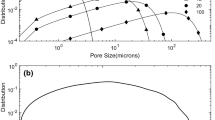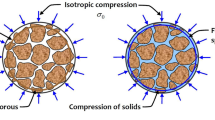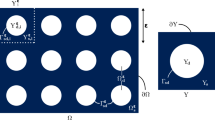Abstract
An efficient numerical technique has been used to compute the deformation of pores of arbitrary shape embedded in a homogeneous elastic solid under the influence of applied stresses. The scheme is based on the boundary-element method, where single linear elements are used to generate solutions that satisfy prescribed boundary conditions. These solutions can be employed to describe the behavior of elastic moduli and other petrophysical properties in porous rocks. The numerical algorithm allows computation of the stress field induced by the pores in the solid. In this way, the effect of the interactions between pores caused by stress concentrations can be studied from a quantitative point of view. To test the algorithm, some interesting results are compared with existing models, for special cases available in the literature. Also, a model for the compressibility and porosity of sedimentary rocks, as a function of applied hydrostatic stress, was generated by mixing some realistic pore geometries generated with the numerical algorithm. Results were in good agreement with data obtained from selected samples of sandstones.
Similar content being viewed by others
REFERENCES
Bell, F. G., 1992, Engineering in rock masses: Butterworth-Heinemann Ltd., 580 p.
Bilby, B. A., and Eshelby, J. D., 1968, Dislocations and the theory of fracture, in Fracture: an advanced treatise, 1: Academic Press, New York, 135 p.
Crouch, S. L., and Starfield, A. M., 1983, Boundary element methods in solid mechanics: George Allen & Unwin, London, 322 p.
Delameter, W. R., 1974, Weakening of Elastic Solids by Arrays of Cracks: PhD dissertation, Dept. of Appl. Mech., Stanford Univ., Stanford, CA, 122 p.
Han, D., Nur, A., and Morgan, D., 1986, Effects of porosity and clay content on velocities of sandstones: Geophysics, v. 51,no. 11, p. 2093–2107.
Inglis, C. E., 1913, Stresses in a plate due to the presence of cracks and sharp corners: Trans. Inst. Naval Archit., v. 55, p. 219.
Landau, L. D., and Lifshitz, E. M., 1959, Theory of elasticity: Addison-Wesley, Reading, MA, 226 p.
Mavko, G., and Nur, A., 1978, The effect of nonelliptical cracks on the compressibility of rocks: Jour. Geophys. Res., v. 83,no. B9, p. 4459–4468.
O'Connell, R. J., and Budiansky, B., 1974, Seismic velocities in dry and saturated cracked solids: Jour. Geophys. Res., v. 79,no. 35, p. 5412–5426.
Sokolnikoff, I. S., 1956, Mathematical theory of elasticity, 2nd edn.: McGraw-Hill, New York, 476 p.
SRP, 1986, The Stanford Rock Physics catalog: Stanford Rock Physics project, v. 3, Stanford University, Stanford, CA, 450 p.
Timoshenko, S. P., and Goodier, J. N., 1970, Theory of elasticity, 3rd edn.: McGraw-Hill, New York, 567 p.
Walsh, J. B., 1965, The effect of cracks on the uniaxial elastic compression of rocks: Jour. Geophys. Res., v. 74,no. 2, p. 399–411.
Author information
Authors and Affiliations
Rights and permissions
About this article
Cite this article
Mendoza, J.S. Computing Petrophysical Properties in Porous Rocks Using a Boundary-Element Technique. Mathematical Geology 30, 889–910 (1998). https://doi.org/10.1023/A:1021782727160
Issue Date:
DOI: https://doi.org/10.1023/A:1021782727160




